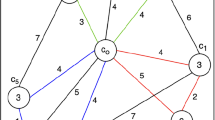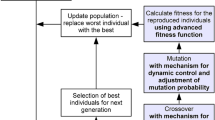Abstract
Airline companies need to organize and manage their route networks in a more cost-efficient and reliable way, in order to cope with increasing customer demands and market changes. This paper attempts to apply complex network concepts and techniques to model airline route networks, and the focus is then put on how to develop an effective and efficient Genetic Algorithm (GA) to optimize airline route networks in terms of certain network properties which are identified to have crucial roles to play in making airline route networks cost-efficient and reliable. The chromosome structure in the proposed GA is based on complex network modelling, and as a result, effective evolutionary operators, particularly a highly efficient uniform crossover operator, are developed. The results demonstrate that the reported GA has a good potential to improve the topology of airline route networks in terms of network properties of interest such as operating costs and network robustness.
Access this chapter
Tax calculation will be finalised at checkout
Purchases are for personal use only
Preview
Unable to display preview. Download preview PDF.
Similar content being viewed by others
References
Dennis, N.P.S., (2002) Long-term route traffic forecasts and flight schedule pattern for a medium-sized European airport. Journal of Air Transport Management 8:313–324
Reynolds-Feighan, A., (2001) Traffic distribution in low-cost and full-service carrier networks in the US air transport market. Journal of Air Transport Management 7:265–275
Burghouwt, G., Hakfoort, J., Van Eck, J.R., (2003) The spatial configuration of airline networks in Europe. Journal of Air Transport Management 9:309–323
Brueckner, J.K. and Spiller, P.T., (1994) Economics of traffic density in the deregulated airline industry. Journal of Law and Economics 37:379–415
Williams, G., (2001) Will Europes charter carriers be replaced by no-frills scheduled airlines? Journal of Air Transport Management 7:277–286
Swan, W.M., (2002) Airline route developments: a review of history. Journal of Air Transport Management 8:349–353
Guimera, R. and Amaral, L.A.N., (2004) Eur. Phys. J. B 38:381
Barrat, A., Barthelemy, M., Pastor-Satorras, R., Vespignani, A., (2004) Proc. Natl. Acad. Sci. USA 101:3747
Boccaletti, S., Latora, V., Moreno, Y, Chaves, M., Hwang, D.U., (2006) Complex networks: Structure and dynamics. Physics Reports 424:175–308
Eiben, A.E. and Schoenauer, M., (2002) Evolutionary computing, Information Processing Letters 82:1–6
Nagata, Y. and S. Kobayashi, S., (1997) Edge assembly crossover: A high-power genetic algorithm for the travelling salesman problem. In, Proceedings of the 7th International Conference on Genetic Algorithms, 450–457
Eiben, A.E. and Smith, J.E., (2003) Introduction to Evolutionary Computing, Berlin: Springer-Verlag
Page, J., Poli, P., Langdon, W.B., (1999) Smooth uniform crossover with smooth point mutation in genetic programming: A preliminary study. In Genetic Programming, Proceedings of EuroGP99, Sweden
Author information
Authors and Affiliations
Editor information
Editors and Affiliations
Rights and permissions
Copyright information
© 2008 Springer-Verlag Berlin Heidelberg
About this chapter
Cite this chapter
Hu, XB., Di Paolo, E. (2008). A Genetic Algorithm Based on Complex Networks Theory for the Management of Airline Route Networks. In: Krasnogor, N., Nicosia, G., Pavone, M., Pelta, D. (eds) Nature Inspired Cooperative Strategies for Optimization (NICSO 2007). Studies in Computational Intelligence, vol 129. Springer, Berlin, Heidelberg. https://doi.org/10.1007/978-3-540-78987-1_45
Download citation
DOI: https://doi.org/10.1007/978-3-540-78987-1_45
Publisher Name: Springer, Berlin, Heidelberg
Print ISBN: 978-3-540-78986-4
Online ISBN: 978-3-540-78987-1
eBook Packages: EngineeringEngineering (R0)




